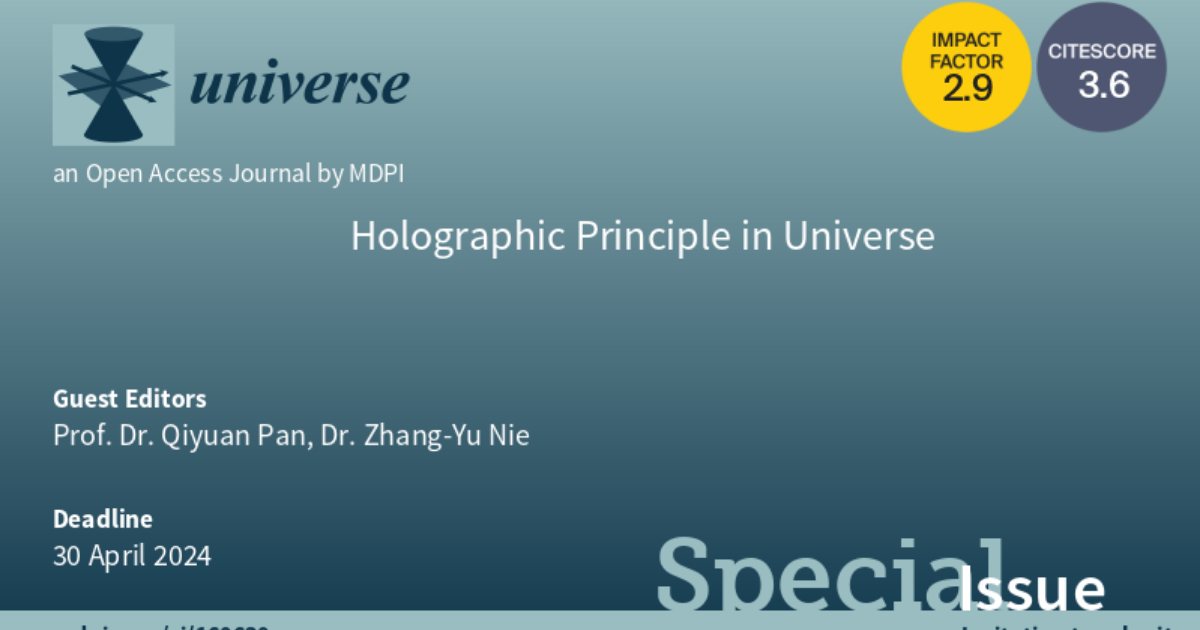Holographic Principle in Universe
A special issue of Universe (ISSN 2218-1997). This special issue belongs to the section "Gravitation".
Deadline for manuscript submissions: 30 April 2024 | Viewed by 612

Special Issue Editors
Interests: gauge/gravity duality; gravitation and cosmology; black holes; quantum information in the relativistic framework
Special Issue Information
Dear Colleagues,
Based on the well-known “spherical entropy bound”, ’t Hooft and Susskind formulated the holographic principle, which states that any quantum gravitational system in (d+1) dimensions should have a dual description in terms of a quantum field theory without gravity in one dimension less. As one of the most important developments in the history of theoretical physics, the holographic principle provides us new insights into the understanding of the real world in the past decade, such as strongly coupled condensed matter systems, quantum chromodynamics (QCD), dark energy and cosmology.
This Special Issue is to inspire new ideas and apply the holographic principle to investigate the central problems of gravity and the universe, which will include (but is not limited by) the following topics:
- Holography and strongly coupled condensed matter systems: Anti–de Sitter/conformal field theory (AdS/CFT) correspondence, quantum phase transitions, charges and finite density, holographic superconductors and superfluids, Fermions, non-relativistic systems and hyperscaling violation;
- Holography and QCD: AdS/QCD correspondence, confinement and chiral symmetry breaking, finite temperature and density;
- Fluid/gravity correspondence, linear response and hydrodynamics;
- Holographic universe, holographic dark energy (HDE) and holographic cosmology;
- Holographic information, holographic entanglement entropy and holographic complexity.
Prof. Dr. Qiyuan Pan
Dr. Zhang-Yu Nie
Guest Editors
Manuscript Submission Information
Manuscripts should be submitted online at www.mdpi.com by registering and logging in to this website. Once you are registered, click here to go to the submission form. Manuscripts can be submitted until the deadline. All submissions that pass pre-check are peer-reviewed. Accepted papers will be published continuously in the journal (as soon as accepted) and will be listed together on the special issue website. Research articles, review articles as well as short communications are invited. For planned papers, a title and short abstract (about 100 words) can be sent to the Editorial Office for announcement on this website.
Submitted manuscripts should not have been published previously, nor be under consideration for publication elsewhere (except conference proceedings papers). All manuscripts are thoroughly refereed through a single-blind peer-review process. A guide for authors and other relevant information for submission of manuscripts is available on the Instructions for Authors page. Universe is an international peer-reviewed open access monthly journal published by MDPI.
Please visit the Instructions for Authors page before submitting a manuscript. Submitted papers should be well formatted and use good English. Authors may use MDPI's English editing service prior to publication or during author revisions.
Keywords
- holographic principle
- gauge/gravity duality
- AdS/CFT correspondence
- AdS/QCD correspondence
- fluid/gravity correspondence
- holographic universe
- holographic information
- holographic gravity






